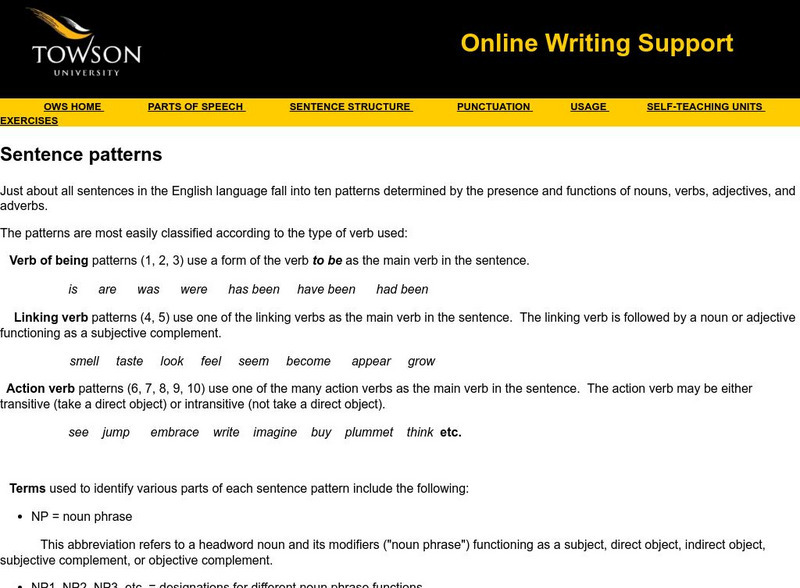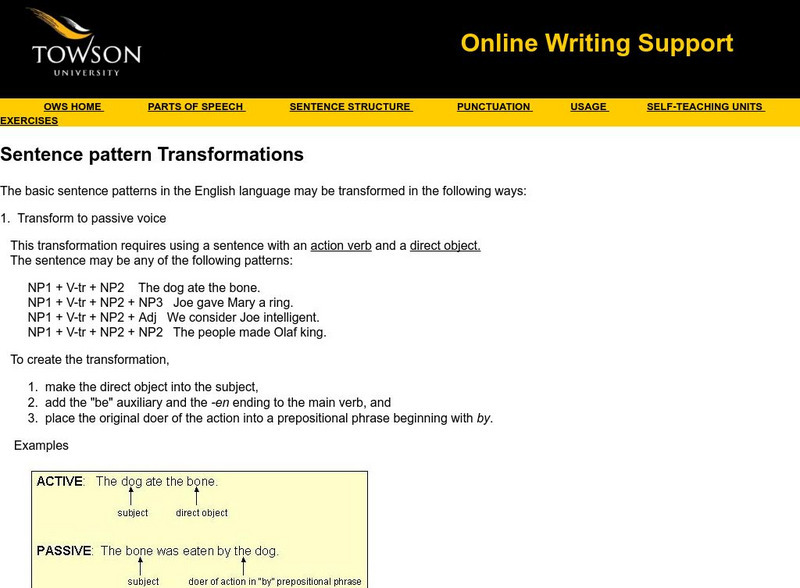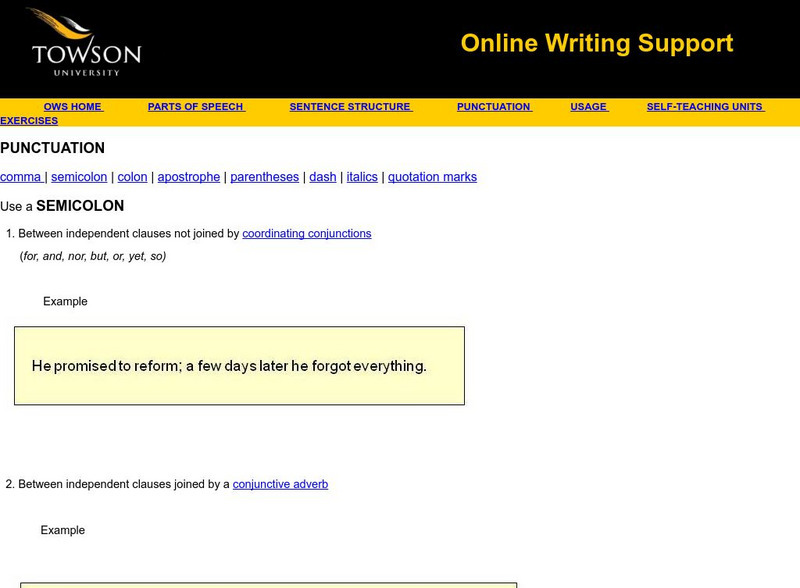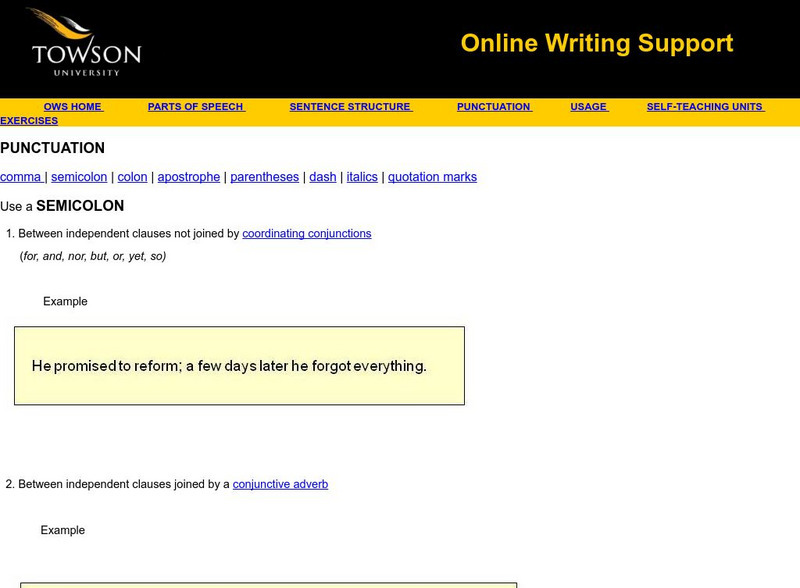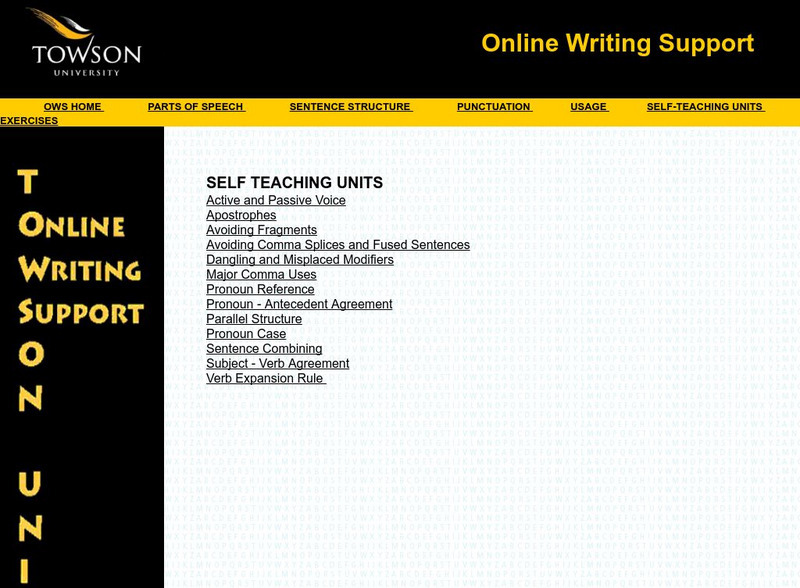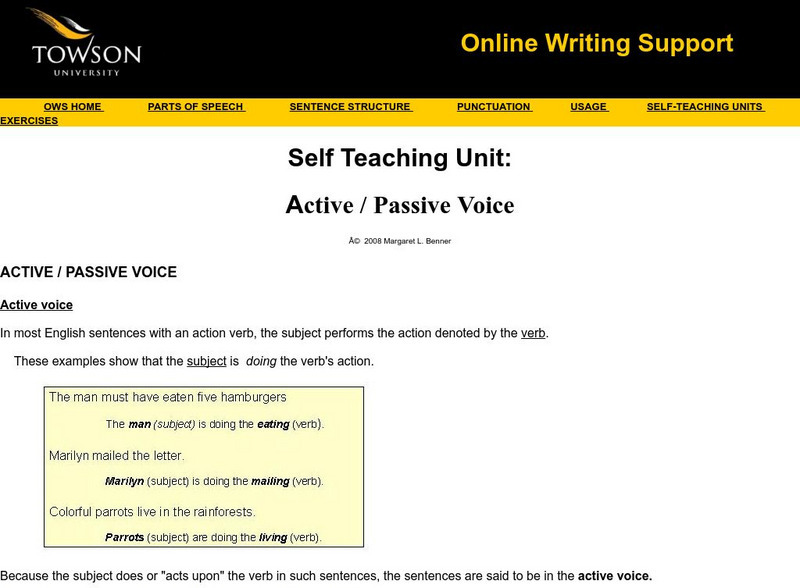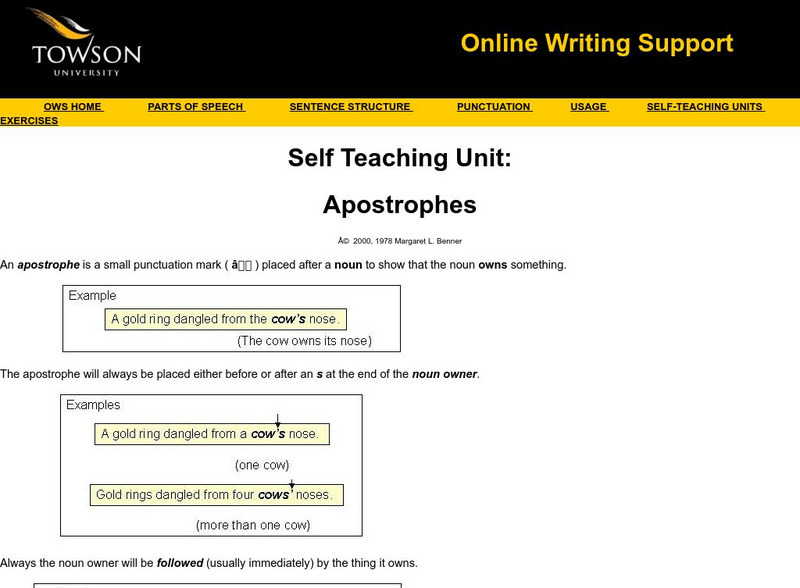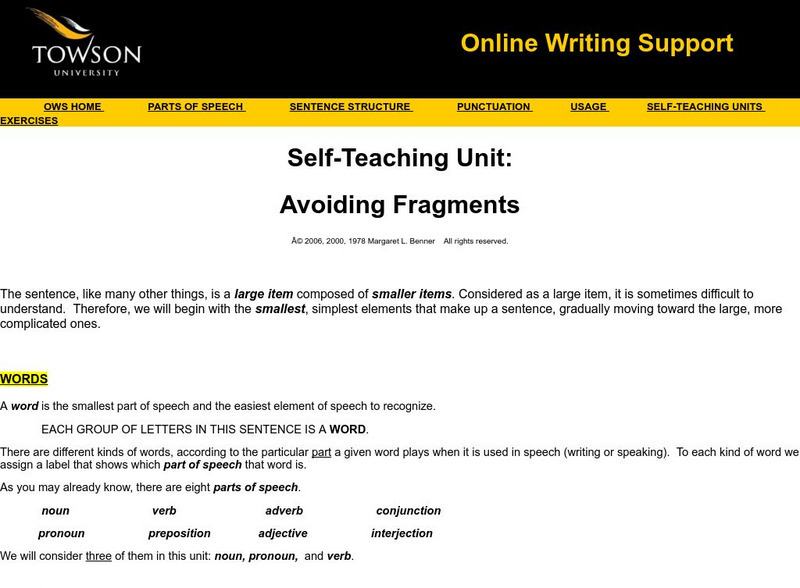Hi, what do you want to do?
Towson University
Towson University: Online Writing Support: Sentence Patterns
This entry explains sentence patterns and lists the 10 sentence patterns that cover most sentences including examples of each.
Towson University
Towson University: Online Writing Support: Sentence Pattern Transformations
This entry focuses on sentence pattern transformations including to active/passive voice, cleft, interrogative with yes or no answer, negative, emphasis, and to interrogative, imperative, or exclamatory. It includes an explanation and...
Towson University
Towson University: Online Writing Support: Active/passive Voice
This entry explains active and passive voice and how to change active to passive and passive to active in sentences. It provides detailed examples of each.
Towson University
Towson University: Online Writing Support: Punctuation
This page provides links to punctuation reference materials for apostrophes, colons, dashes, commas, parentheses, italics, quotation marks, and semicolons.
Towson University
Towson University: Online Writing Support: Apostrophe
This entry explains and provides examples of when and how to use the apostrophe to show ownership and to form the plural of letters, numbers, and signs used as words. It also explains when not to use apostrophes such as with the pronoun...
Towson University
Towson University: Online Writing Support: Colon
This entry focuses on the when and how to use a colon including to formally introduce a list, between two independent clauses, before a formal appositive, and between hour and minute / chapter and verse. It includes detailed examples of...
Towson University
Towson University: Online Writing Support: Comma
This entry focuses on the rules for comma use including listing the uses, explaining the rules, and providing detailed examples.
Towson University
Towson University: Online Writing Support: Dash
This entry explains the uses for the dash and provides examples.
Towson University
Towson University: Online Writing Support: Italics
This entry provides the rules and examples for when and how to use italics and quotation marks in titles, quotations, and more.
Towson University
Towson University: Online Writing Support: Parentheses
This entry explains the uses for parentheses and provides examples.
Towson University
Towson University: Online Writing Support: Quotation Marks
This entry provides the rules for using quotation marks and single quotation marks and provides examples of each use.
Towson University
Towson University: Online Writing Support: Semicolon
This entry provides the rules for semicolon use and examples of each including between independent clauses without coordinating conjunctions, between independent clauses with a conjunctive adverb, and between items in a series containing...
Towson University
Towson University: Online Writing Support: Exercises
This page offers a list of links to exercises/quizzes on the following topics: Parts of Speech/Grammar; Prepositional and Verbal Phrases; Adjectival, Adverbial, Nominal Phrases, and Clauses; Punctuation, Sentence Structure, Usage,...
Towson University
Towson University: Online Writing Support: Self Teaching Units
This page provides a list of links to self-teaching units on grammar, punctuation, sentence structure, active and passive voice, and more. Each provides an explanation with examples, followed by a practice exercise.
Towson University
Towson University: Ows: Self Teaching Unit: Active / Passive Voice
This module defines the active and passive voice and explains how to change active to passive voice and passive to active voice. It offers examples of each, practice exercises, and a link to a printable quiz/exercise.
Towson University
Towson University: Online Writing Support: Self Teaching Units: Apostrophes
This module explains how to use apostrophes to form possessive nouns and pronouns, provides links to exercises for each new idea, and a link to a post lesson quiz.
Towson University
Towson University:online Writing Support: Self Teaching Unit: Avoiding Fragments
This module focuses on what makes a sentence including parts of speech, subjects and predicates, and phrases and clauses. It then explains fragments and how to avoid them. It offers links to several exercises and a post-quiz.
Towson University
Towson University: Ows: Self Teaching Unit: Comma Splices and Fused Sentences
This lesson starts with the simple sentence and explains sentence parts, independent clauses, types of sentences, coordinating conjunctions, conjunctive adverbs, and sentence errors (comma splices and fused sentences). Links to practice...
Towson University
Towson University: Self Teaching Unit: Avoiding Misplaced and Dangling Modifiers
This lesson focuses on misplaced modifiers including adjectives, adverbs, phrases, and clauses and dangling modifiers. It discusses each, provides examples, explains how to correct them, and offers links to exercises and a post-quiz.
Towson University
Towson University: Ows: Self Teaching Unit: Major Comma Uses
This lesson focuses on comma rules including the rules, examples, links to exercises and a link to a final quiz.
Towson University
Towson University: Ows: Self Teaching Unit: Pronoun Antecedent Agreement
This lesson focuses on pronouns including personal pronouns, singular and plural personal pronouns, indefinite pronouns, and pronoun-antecedent agreement. It provides examples of each, explains types of errors and how to correct them,...
Towson University
Towson University: Ows: Self Teaching Unit: Parallel Structure
This lesson focuses on parallel structure including how to recognize parallel structure, when parallel construction is important, and how to correct faulty parallelism. It provides examples of each and links to exercises and a final quiz.
Towson University
Towson University:online Writing Support: Self Teaching Unit: Sentence Combining
This lesson focuses on sentence combining including showing sentence errors and their corrections, providing six methods of combining sentences with examples of each and offering a link to a final quiz.
Towson University
Towson University: Ows: Self Teaching Unit: Subject Verb Agreement
This lesson focuses on subject-verb agreement; it provides the rules, examples of each, and links to several exercises and a post-test.





